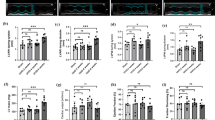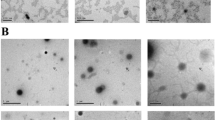Abstract
Purpose
The aim of this study was to investigate the effect of renal cortex transient receptor potential melastatin 7 (TRPM7) suppression on renal ischemia reperfusion injury induced by transplantation in mice.
Methods
M7shRNA was used to decrease the expression of TRPM7 in NRK-52e cells. The mice were subjected to renal intra-parenchymal injection with lentivirus containing M7shRNA to produce hypo-expression of TRPM7 in renal cortex. Cell hypoxia mode and syngeneic renal transplantation in vivo were established. Then the effects of M7shRNA were measured by fluorescent probe for reactive oxygen species (ROS), intracellular calcium and magnesium; Western blot was applied for p38-MAPKs and Bax expression in cell studies. In vivo studies, mice were killed 24 h, 48 h, 72 h, 7 days and 21 days, respectively, after transplantation and the kidneys were dissected. Serum creatinine was measured, and the H&E, Masson’s trichrome staining, TUNEL, Kim-1 and α-smooth muscle actin were used to evaluate pathological change.
Results
In cell model of hypoxia, the level of ROS in NRK-52e-M7shRNA was significantly lower than that in both NRK-52e and NRK-52e control cells, while the activation of p38-MAPKs was limited. In renal transplanted mice, renal function of M7shRNA group was conspicuously better than PBS- and vector-control-treated group. The histological examination showed that renal tubule injury and interstitial fibrosis were lower in M7shRNA-treated group compared with PBS and vector-control group.
Conclusions
Suppression of renal cortex TRPM7 could alleviate kidney injury induced by transplantation in mice. The mechanism may involve reducing the early stage of ischemia reperfusion injury by inhibition of intracellular Ca2+, Mg2+ and ROS.




Similar content being viewed by others
References
Jones DR, Lee HT (2007) Protecting the kidney during critical illness. Curr Opin Anaesthesiol 20:106–112
Tang IY, Murray PT (2004) Prevention of perioperative acute renal failure: what works? Best Pract Res Clin Anaesthesiol 18:91–111
Chapman JR, O’Connell PJ, Nankivell BJ (2005) Chronic renal allograft dysfunction. J Am Soc Nephrol 16:3015–3026
Schwarz A, Mengel M, Gwinner W, Radermacher J, Hiss M, Kreipe H et al (2005) Risk factors for chronic allograft nephropathy after renal transplantation: a protocol biopsy study. Kidney Int 67:341–348
Gulati P and Singh N (2013) Neuroprotective effect of tadalafil, a PDE-5 inhibitor, and its modulation by L-NAME in mouse model of ischemia-reperfusion injury. J Surg Res
Nadler MJ, Hermosura MC, Inabe K, Perraud AL, Zhu Q, Stokes AJ et al (2001) LTRPC7 is a Mg.ATP-regulated divalent cation channel required for cell viability. Nature 411:590–595
Runnels LW, Yue L, Clapham DE (2001) TRP-PLIK, a bifunctional protein with kinase and ion channel activities. Science 291:1043–1047
Aarts M, Iihara K, Wei WL, Xiong ZG, Arundine M, Cerwinski W et al (2003) A key role for TRPM7 channels in anoxic neuronal death. Cell 115:863–877
Su LT, Chen HC, Gonzalez-Pagan O, Overton JD, Xie J, Yue L et al (2010) TRPM7 activates m-calpain by stress-dependent stimulation of p38 MAPK and c-Jun N-terminal kinase. J Mol Biol 396:858–869
Chen HC, Su LT, Gonzalez-Pagan O, Overton JD, Runnels LW (2012) A key role for Mg2+ in TRPM7′s control of ROS levels during cell stress. Biochemical Journal 445:441–448
Gutteridge JM, Halliwell B (1992) Comments on review of free radicals in biology and medicine, second edition, by Barry Halliwell and John M. C. Gutteridge. Free Radic Biol Med 12:93–95
Meng Z, Wang X, Yang Z, Xiang F (2012) Expression of transient receptor potential melastatin 7 up-regulated in the early stage of renal ischemia-reperfusion. Transplant Proc 44:1206–1210
Lange C, Togel F, Ittrich H, Clayton F, Nolte-Ernsting C, Zander AR et al (2005) Administered mesenchymal stem cells enhance recovery from ischemia/reperfusion-induced acute renal failure in rats. Kidney Int 68:1613–1617
Wei WL, Sun HS, Olah ME, Sun X, Czerwinska E, Czerwinski W et al (2007) TRPM7 channels in hippocampal neurons detect levels of extracellular divalent cations. Proc Natl Acad Sci USA 104:16323–16328
Sun HS, Jackson MF, Martin LJ, Jansen K, Teves L, Cui H et al (2009) Suppression of hippocampal TRPM7 protein prevents delayed neuronal death in brain ischemia. Nat Neurosci 12:1300–1307
Kim M, Chen SW, Park SW, Kim M, D’Agati VD, Yang J et al (2009) Kidney-specific reconstitution of the A1 adenosine receptor in A1 adenosine receptor knockout mice reduces renal ischemia-reperfusion injury. Kidney Int 75:809–823
Su LT, Agapito MA, Li M, Simonson WT, Huttenlocher A, Habas R et al (2006) TRPM7 regulates cell adhesion by controlling the calcium-dependent protease calpain. J Biol Chem 281:11260–11270
Chen C, Peng J, Xia HS, Yang GF, Wu QS, Chen LD et al (2009) Quantum dots-based immunofluorescence technology for the quantitative determination of HER2 expression in breast cancer. Biomaterials 30:2912–2918
Siedlecki AM, Jin X, Thomas W, Hruska KA, Muslin AJ (2011) RGS4, a GTPase activator, improves renal function in ischemia-reperfusion injury. Kidney Int 80:263–271
Vieira JM Jr, Mantovani E, Rodrigues LT, Delle H, Noronha IL, Fujihara CK et al (2005) Simvastatin attenuates renal inflammation, tubular transdifferentiation and interstitial fibrosis in rats with unilateral ureteral obstruction. Nephrol Dial Transplant 20:1582–1591
Jablonski P, Howden BO, Rae DA, Birrell CS, Marshall VC, Tange J (1983) An experimental model for assessment of renal recovery from warm ischemia. Transplantation 35:198–204
Kakuta Y, Okumi M, Isaka Y, Tsutahara K, Abe T, Yazawa K et al (2011) Epigallocatechin-3-gallate protects kidneys from ischemia reperfusion injury by HO-1 upregulation and inhibition of macrophage infiltration. Transpl Int 24:514–522
Brinkkoetter PT, Song H, Losel R, Schnetzke U, Gottmann U, Feng Y et al (2008) Hypothermic injury: the mitochondrial calcium, ATP and ROS love-hate triangle out of balance. Cell Physiol Biochem 22:195–204
Brookes PS, Yoon Y, Robotham JL, Anders MW, Sheu SS (2004) Calcium, ATP, and ROS: a mitochondrial love-hate triangle. Am J Physiol Cell Physiol 287:C817–C833
Zhou H, Clapham DE (2009) Mammalian MagT1 and TUSC3 are required for cellular magnesium uptake and vertebrate embryonic development. Proc Natl Acad Sci USA 106:15750–15755
Uehara T, Peng XX, Bennett B, Satoh Y, Friedman G, Currin R (2004) c-Jun N-terminal kinase mediates hepatic injury after rat liver transplantation. Transplantation 78:324–332
Clanachan AS, Jaswal JS, Gandhi M, Bottorff DA, Coughlin J, Finegan BA et al (2003) Effects of inhibition of myocardial extracellular-responsive kinase and P38 mitogen-activated protein kinase on mechanical function of rat hearts after prolonged hypothermic ischemia. Transplantation 75:173–180
Wykes RC, Lee M, Duffy SM, Yang W, Seward EP, Bradding P (2007) Functional transient receptor potential melastatin 7 channels are critical for human mast cell survival. J Immunol 179:4045–4052
Mackins CJ, Kano S, Seyedi N, Schafer U, Reid AC, Machida T et al (2006) Cardiac mast cell-derived renin promotes local angiotensin formation, norepinephrine release, and arrhythmias in ischemia/reperfusion. J Clin Invest 116:1063–1070
Vural KM, Liao H, Oz MC, Pinsky DJ (2000) Effects of mast cell membrane stabilizing agents in a rat lung ischemia-reperfusion model. Ann Thorac Surg 69:228–232
Abonia JP, Friend DS, Austen WG Jr, Moore FD Jr, Carroll MC, Chan R et al (2005) Mast cell protease 5 mediates ischemia-reperfusion injury of mouse skeletal muscle. J Immunol 174:7285–7291
Middelbeek J, Kuipers AJ, Henneman L, Visser D, Eidhof I, van Horssen R et al (2012) TRPM7 is required for breast tumor cell metastasis. Cancer Res 72:4250–4261
Acknowledgments
The authors would like to thank Professor Loren Runnels for his great assistance. The study was supported by grants from the National Natural Science Foundation of China (No.81172734 and No. 81202027) and Fundamental Research Funds for the Central Universities (No. 2012303020211).
Conflict of interests
None.
Author information
Authors and Affiliations
Corresponding author
Rights and permissions
About this article
Cite this article
Meng, Z., Cao, R., Wang, Y. et al. Suppression of renal TRPM7 may alleviate kidney injury in the renal transplantation. World J Urol 32, 1303–1311 (2014). https://doi.org/10.1007/s00345-013-1208-y
Received:
Accepted:
Published:
Issue Date:
DOI: https://doi.org/10.1007/s00345-013-1208-y




